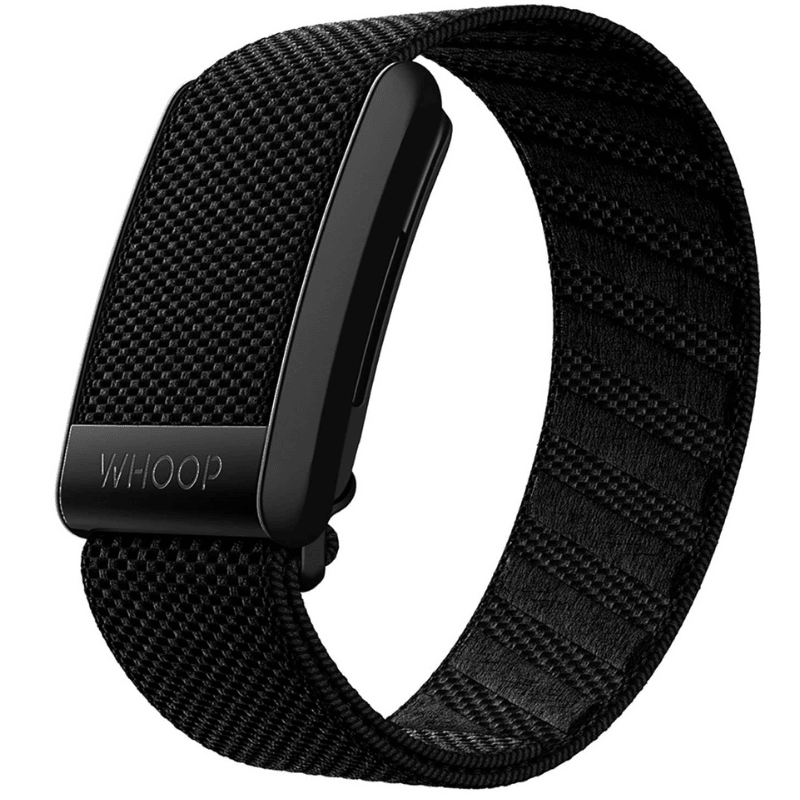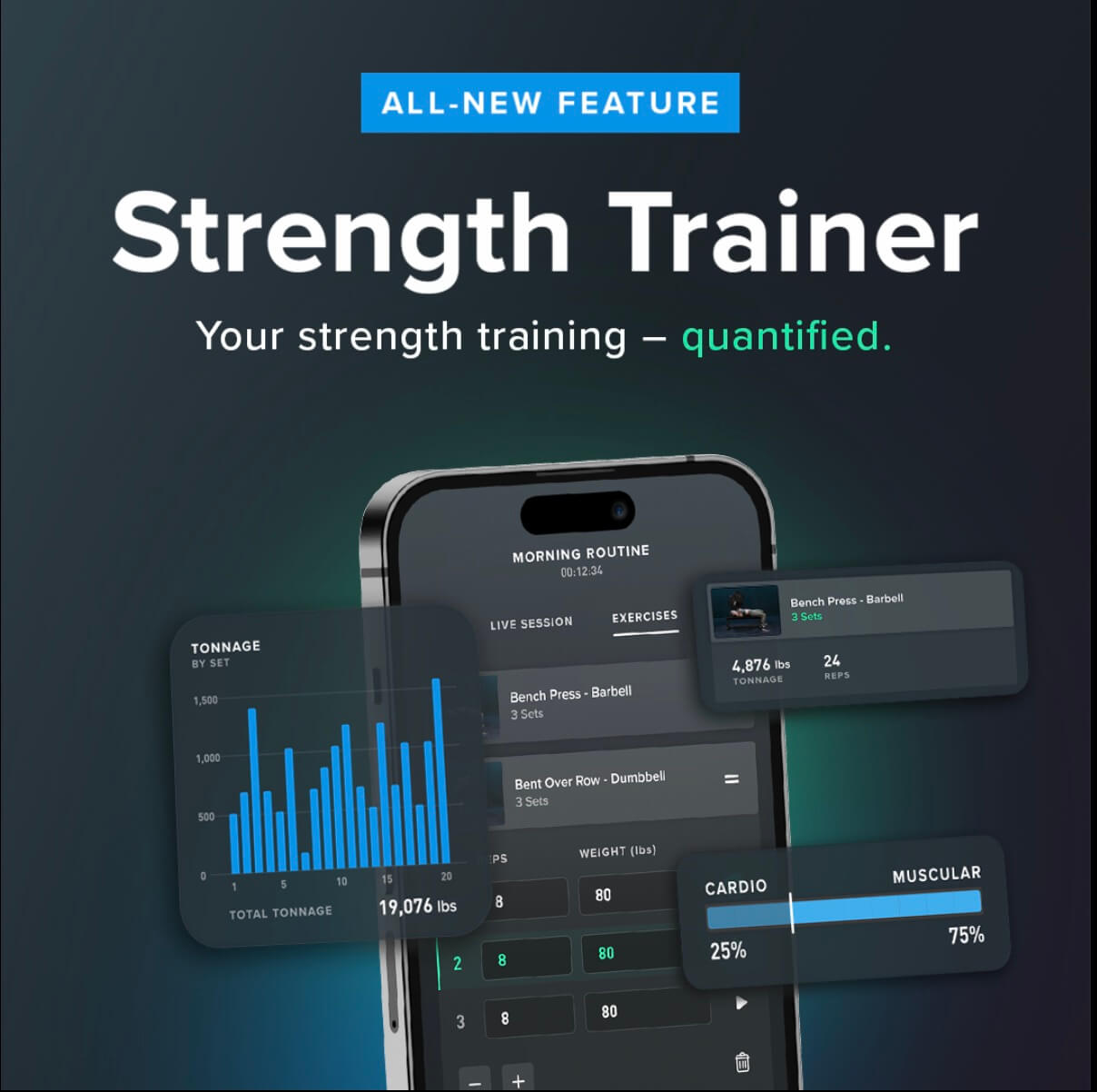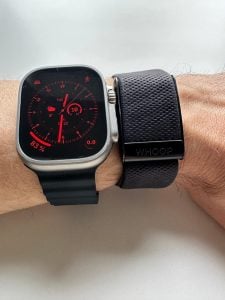Whoop is an American wearable tech company based in Boston that is famous for creating a no-display fitness tracker used by top athletes in swimming (Michael Phelps), Crossfit (Rich Froning), and members of the EF Pro cycling team. As an amateur calisthenics athlete and cyclist, I’ve also been an avid Whoop user for the last 16 months.
Besides the Whoop I've also been wearing the Apple Watch Ultra and in this article, I explain which one I would choose as my go-to fitness tracker.
WHOOP 4.0 Strap

*when you make a purchase we may earn a commission at no extra cost to you
- Best fitness, sleep and recovery tracking app.
- Device is free but needs annual subscription.
- Compact size - put on and forget.
- Creative WHOOP accessories
- Constant monitoring
Pros & Cons
Pros
- Super small size makes you forget that you're wearing it.
- You can also wear it with an arm band or hide inside clothes (e.g. underwear).
- No display means no distractions. Everything gets logged in the background and available to see on your phone.
- Very well designed app. Great charts and long term trend visualisations.
- 4 days of battery life.
- Constant monitoring. It comes with a battery pack sleeve that you can put on while wearing it.
- You can stream heart rate to other devices (e.g. Garmin computer for cyclists)
Cons
- Requires annual subscription.
- Plastic design and not so premium feel.
- Limited band options. The default band gets wet when sweating.
- You can only use it for one thing - fitness & sleep tracking.
- For its size and lack of display the battery life could be better.
Bottom Line
What’s new with the Whoop Strength Trainer
Today, Whoop announced a new software feature called Strength Trainer which enables athletes to track both muscular load and cardiovascular load. It is available for all users with the newest Whoop 4.0 band.
The eternal problem with wearables today - which makes most of them useless for strength training - is that the main input they rely on is the heart rate sensor. They can track the cardiovascular load during the workout which is mostly useful for endurance type of activities such as running and cycling.
When we do heavy dips or weighted pull ups the body is only under tension for a short time which isn’t enough for the heart rate to catch up. Our effort is simply not reflected if we only look at the heart rate data.
The real novelty is that the Whoop Strength Trainer quantifies the muscular load during workouts by tracking weights, reps, and sets to calculate the overall workout volume and Strain score.
Calculating muscular load
The algorithm behind the muscular load takes the movement profile of an exercise (which is pre-programmed I assume) and combines it with the accelerometer and gyroscope sensor data to understand the volume and intensity of the workout. In addition, they also factor your workout history into the calculation.
The reason for this approach is that “Different movements have different movement profiles and use a different percentage of the total musculoskeletal system. For instance, a back squat has a different load profile than a calf raise because it uses more muscles and joints, creating higher muscular load.” - says Whoop in their press release.
What they say about the movements makes total sense but I’m still unsure how they can calculate the load profile accurately given that they don’t know my precise body measurements and the exact time under tension. Only time and repeat testing will tell how accurate it is.
How to workout with the Whoop Strength Trainer
First and foremost, you have to wear the Whoop device on your wrist. The Strength Trainer can only give you useful data if it is able to track wrist movement.
Once you open the app you will find the Strength Trainer under the "Plus" button in the bottom right of the welcome screen. After selecting the "Strength trainer" option you will be prompted through a few slides explaining the new features (see gallery below).
Build your own workout using the exercise library
The exercise library is pre-loaded with over 200 exercises. The execution of each exercise is explained in writing and in a video demonstration.
Unfortunately, most of the exercises require a barbell, dumbbell, or some sort of machine. There are many bodyweight exercises missing so in this form it's not that useful for calisthenics training. I'm assuming the exercise library will gradually expand so I will update this article over time.
Another limitation for calisthenics is that when building your workout it requires you to assign a weight to each exercise. For a pull up I just added my bodyweight but it's trickier to calculate for a bodyweight row or elevated push up where the load depends on the body's position.
Pick one of the 15 pre-built workouts
If you are feeling lazy, or just want to try Michael Phelps' workout, you can also do that. Currently, there are 15 pre-built workouts available in the library. The exercises, sets, and reps are pre-set but you are able to edit all of that.
I was expecting a train-along or at least a demonstration of the exercises by the athletes who are featuring them but it looks like, they are just the "name givers". I wonder how involved they were in the planning of the workouts.
Once you selected your workout and hit start, the interface is the same as for the workouts you built yourself.
Here too, I would like to see more bodyweight-oriented workouts to satisfy those who want to train at home or have no access to gym equipment.
Workout summary
At the end of the workout, you are presented with the prompt to rate your perceived exertion. Once you dragged the scale you will see your Strain breakdown and the Workout details.
As you can see the app counts for you the total number of repetitions and the total amount of weight moved during the workout.
My strain for this workout was zero because I just did training before and wanted to quickly try the new features. I will update this review after using it a few times with more impressions.
Conclusion
Whoop has realized the gap in the wearable market for strength training and I think they are going in the right direction with this update. The main limitation is the state of the sensor technology, the size that fits on our wrist, and the battery capacity. Currently, Whoop has the best interface for fitness tracking and brings out the maximum that is allowed by the hardware. The Strength Trainer is definitely a work in progress but I'm excited to see how it works and evolves over the next few months.
Would I recommend Whoop for calisthenics?
I've been a long-time Whoop user and will continue using it for sleep tracking and tracking my workouts. I enjoy the insights it gives me into the long-term trends of my strain and recovery. Unfortunately in its current form, the Strength Trainer is not very useful for calisthenics. To make it more usable the app would need more body weight and weighted calisthenics exercises in the library as well as more relevant pre-loaded workouts. With the addition of calisthenics specific exercises - which factor in the muscular load into the algorithm - both the Strain breakdown and Workout details would give much better insights into my training.




